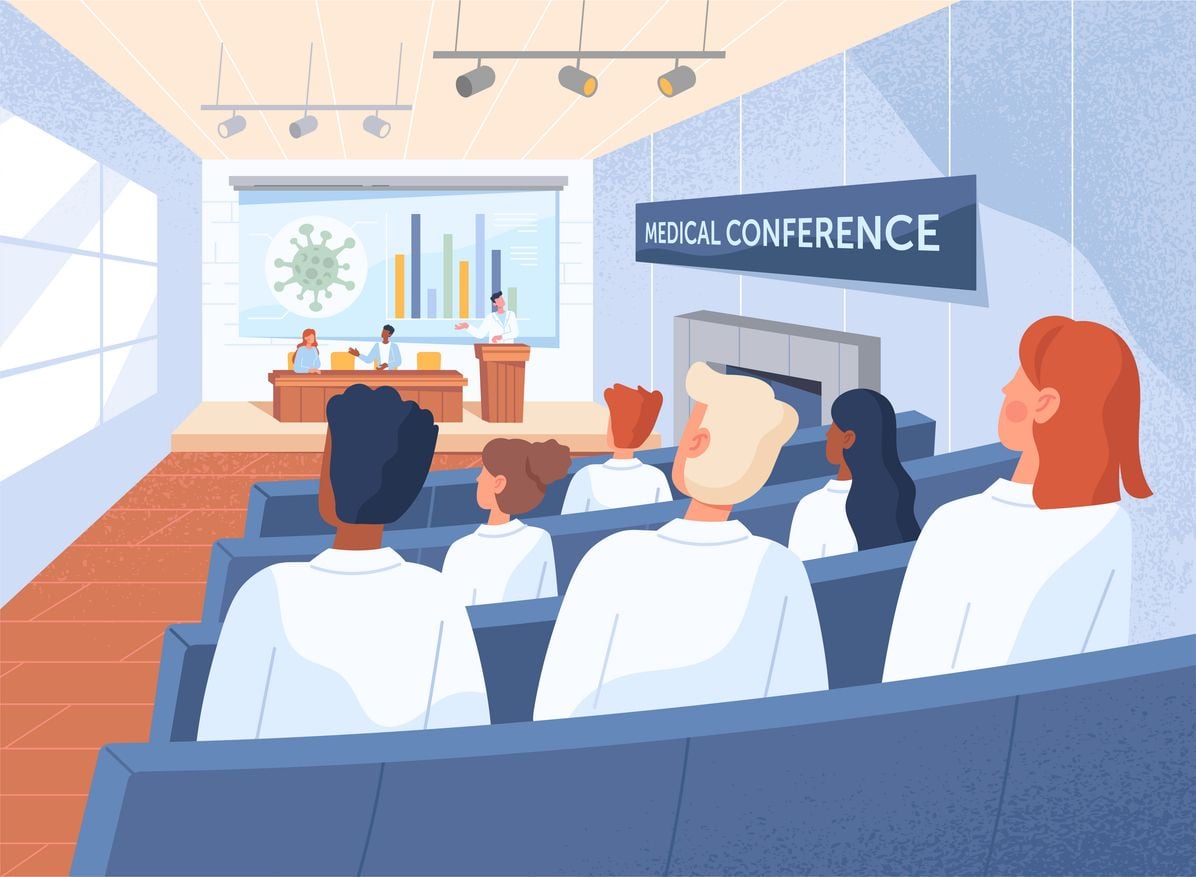The art of conference coverage: Turning science into insight
)
How skilled medical writing transforms live research into lasting impact
Every year, medical and scientific conferences bring together thousands of healthcare professionals, researchers, and thought leaders to share the latest clinical breakthroughs, trial results, and innovations in patient care. From headline-making plenary sessions to niche symposia, these events are packed with new data and emerging ideas. But with limited time and overlapping sessions, it’s impossible for any one attendee to absorb everything. That’s where expert medical writers step in.
Conference reporting is an essential service in today’s fast-moving healthcare landscape. This involves capturing the essence of medical meetings and transforming scientific presentations into clear, engaging summaries that inform and inspire a broader audience.
In this article, we explore the craft of conference coverage and how medical writers turn real-time science into meaningful, enduring insight.
Why conference coverage matters
Medical conferences are where clinical frontiers are pushed forward. They showcase real-time data, provide first glimpses of major trial outcomes, and reflect evolving standards of care. But attending a conference is just the beginning. What truly adds value is how those insights are captured, interpreted, and communicated after the event.
Healthcare professionals, pharmaceutical companies, academic institutions, and patient advocacy groups all rely on conference summaries to:
- Stay up to date on the latest developments
- Identify key takeaways relevant to their practice or focus area
- Share findings with internal teams or external audiences
- Inform strategic decisions and educational initiatives
Effective conference coverage helps bridge the gap between live events and lasting knowledge, ensuring the science reaches the people who need it most.
The role of the medical writer in conference reporting
A skilled medical writer brings more than just note-taking ability to the table. Their role involves synthesising complex scientific content, understanding clinical significance, and shaping the material to meet the needs of a specific audience. This requires not only fluency in medical language but also deep editorial judgment.
At a high level, conference coverage by a medical writer includes:
- Attending or reviewing selected sessions (live or virtual)
- Identifying headline findings, trends, and expert commentary
- Summarising trial data with clinical context and clarity
- Developing deliverables tailored to clients, such as daily highlights, slide decks, blog posts, newsletters, or internal reports
- Adhering to style, tone, regulatory requirements, and deadlines
Medical reporting ethics
Medical writers have an ethical responsibility to present information as clearly and accurately as possible and without bias. Medical writers must be transparent about sources, respectful of intellectual property, and mindful of potential conflicts of interest. It is important to prioritise patient welfare, scientific integrity, and accuracy over commercial considerations.
Turning presentations into practical summaries
Capturing the essence of a conference session means more than transcribing what was said. Medical writers must translate dense data into digestible content and make it relevant to practice. This requires:
- Understanding the science
Whether it's a late-breaking clinical trial or a nuanced panel discussion, the writer must grasp the study design, endpoints, population, and clinical implications. - Knowing what matters
Not every data point is equally important. Skilled writers highlight what’s new, what’s practice-changing, and what the experts emphasised. - Writing for the audience
A summary for an internal medical affairs team will differ in tone and depth from one for a public-facing blog. Good writers know how to adapt style and messaging accordingly. - Being accurate and timely
Conference coverage often has fast turnarounds. Writers must be able to work quickly without sacrificing accuracy, a hallmark of trusted communication.
Types of conference deliverables
Medical writers may be asked to create a variety of content types based on conference sessions, including:
- Scientific highlights and daily digests
Short, focused summaries of each day’s most important sessions - Key takeaway reports
A structured document summarising major trends, data, and insights - Presentation summaries
Detailed reports on individual talks or poster sessions - Internal briefings
Confidential summaries for use by commercial, medical, or research teams - Slide decks or visual summaries
Designed to support education or team debriefs - Blog articles or newsletters
Public-facing content tailored for broader audiences
Each format requires a different balance of detail, tone, and framing, but all require clarity and insight.
Challenges in conference coverage
Conference reporting presents unique challenges, including:
- Information overload: Dozens of sessions run simultaneously; writers must select and prioritise wisely.
- Incomplete data: Not all presenters provide full datasets; writers must be cautious and avoid overinterpretation.
- Time pressure: Summaries are often needed within 24-48 hours.
- Audience diversity: Content may need to suit multiple stakeholders, from scientific peers to sales teams.
An experienced medical writer knows how to navigate these challenges while maintaining quality and compliance.
What sets great conference coverage apart
Great conference coverage combines:
- Scientific fluency
- Audience awareness
- Strategic insight
- Editorial precision
- Fast, flexible delivery
Medical writers and medical journalists bring these elements together to create summaries that go beyond the surface by connecting data with its real-world implications.
Final thoughts
Medical conferences are where science takes its next leap forward. But without clear communication, even the most groundbreaking data can get lost in the noise. Medical writers play a crucial role in ensuring that the insights shared at these events are captured, contextualised, and carried forward.
Whether you're a pharmaceutical company needing rapid insights, a clinician short on time, or a comms team looking to amplify scientific messages, conference coverage by an experienced medical writer turns fleeting presentations into enduring value.
---
Frequently Asked Questions (FAQs)
Q: What is medical conference coverage?
A: Conference coverage involves summarising the key presentations, data, and insights shared at medical or scientific conferences. It helps communicate important findings to audiences who couldn’t attend or need a clear, concise recap of what matters most.
Q: Why do organisations need conference coverage?
A: Healthcare professionals, pharmaceutical companies, and academic teams often don’t have the time or capacity to attend every session or review raw materials. Conference summaries keep them informed of emerging trends, clinical data, and potential practice changes—quickly and accurately.
Q: What does a medical writer do during conference coverage?
A: A medical writer attends or reviews key sessions, identifies the most relevant insights, and produces tailored content such as summaries, reports, slide decks, or blog posts. They turn complex science into clear, actionable information suited to the target audience.
Q: What types of deliverables can a medical writer create from a conference?
A: Deliverables may include scientific highlights, daily digests, internal briefings, slide decks, presentation summaries, newsletters, and public-facing blog articles. Each is adapted in tone and detail for the intended audience.
Q: Who is the target audience for conference coverage content?
A: Depending on the client, audiences may include internal teams (e.g., medical affairs, R&D, sales), external healthcare professionals, journalists, policymakers, or patients. Skilled writers tailor the message to match each audience’s needs and level of expertise.
Q: How quickly can a medical writer deliver conference coverage?
A: Many clients require content within 24-48 hours of session completion. Professional medical writers are experienced in working under tight deadlines while maintaining scientific accuracy and editorial quality.
Q: What are the biggest challenges in covering medical conferences?
A: Challenges include information overload, simultaneous sessions, incomplete data, and fast turnaround times. Writers must also interpret findings cautiously and avoid overclaiming—especially when preliminary data is presented.
Q: What makes great conference coverage stand out?
A: High-quality coverage highlights what’s new and important, explains why it matters, and presents it clearly and concisely. Great writers combine scientific understanding with strong editorial skills and audience awareness.
---
Looking for high-quality, audience-tailored conference reporting?
Contact KMG Communications. We turn science into insight - on time, every time. KMG Communications provides expert medical writing for medical and scientific conferences. We offer fast, accurate, and audience-tailored summaries that translate complex science into real insight - helping our clients stay informed, make decisions, and share knowledge with impact.
---
References
Traynor K. 2010. Secrets from the seasoned: Making a medical conference work for you [Internet]. National Association of Science Writers Inc. https://www.nasw.org/article/secrets-seasoned-making-medical-conference-work-you
---
Author: Kara Gilbert, KMG Communications
| Tags:Latest News |

)